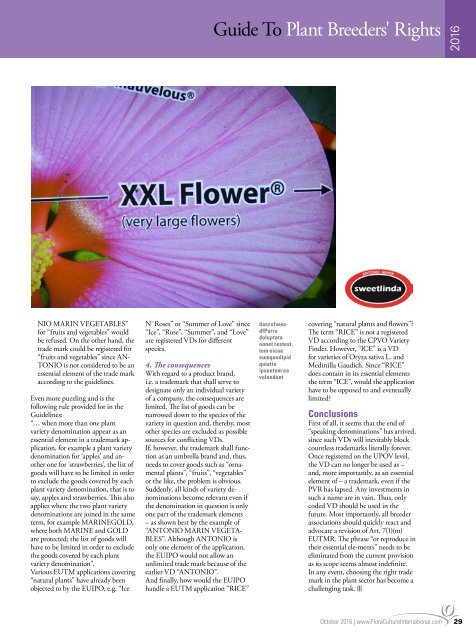2016 CIOPORA Guide to Plant Breeders' Rights
CIOPORA annual magazine on Intellectual Property protection for plant innovations. Produced in cooperation with FloraCulture International. Read in the 2016 issue: - CIOPORA completes positions on Plant Breeders´ Rights - Does the U.S. miss out on additional new varieties developed abroad? - Update on the Nagoya Protocol and its EU implementation - Intellectual Property Systems: a tool, not a goal - European Trademarks and Variety : The chaos has arrived.
CIOPORA annual magazine on Intellectual Property protection for plant innovations. Produced in cooperation with FloraCulture International.
Read in the 2016 issue:
- CIOPORA completes positions on Plant Breeders´ Rights
- Does the U.S. miss out on additional new varieties developed abroad?
- Update on the Nagoya Protocol and its EU implementation
- Intellectual Property Systems: a tool, not a goal
- European Trademarks and Variety : The chaos has arrived.
Create successful ePaper yourself
Turn your PDF publications into a flip-book with our unique Google optimized e-Paper software.
<strong>Guide</strong> To <strong>Plant</strong> <strong>Breeders'</strong> <strong>Rights</strong><br />
<strong>2016</strong><br />
NIO MARIN VEGETABLES”<br />
for “fruits and vegetables” would<br />
be refused. On the other hand, the<br />
trade mark could be registered for<br />
“fruits and vegetables” since AN-<br />
TONIO is not considered <strong>to</strong> be an<br />
essential element of the trade mark<br />
according <strong>to</strong> the guidelines.<br />
Even more puzzling and is the<br />
following rule provided for in the<br />
<strong>Guide</strong>lines:<br />
“… when more than one plant<br />
variety denomination appear as an<br />
essential element in a trademark application,<br />
for example a plant variety<br />
denomination for ‘apples’ and another<br />
one for ‘strawberries’, the list of<br />
goods will have <strong>to</strong> be limited in order<br />
<strong>to</strong> exclude the goods covered by each<br />
plant variety denomination, that is <strong>to</strong><br />
say, apples and strawberries. This also<br />
applies where the two plant variety<br />
denominations are joined in the same<br />
term, for example MARINEGOLD,<br />
where both MARINE and GOLD<br />
are protected; the list of goods will<br />
have <strong>to</strong> be limited in order <strong>to</strong> exclude<br />
the goods covered by each plant<br />
variety denomination”.<br />
Various EUTM applications covering<br />
“natural plants” have already been<br />
objected <strong>to</strong> by the EUIPO, e.g. “Ice<br />
N’ Roses” or “Summer of Love” since<br />
“Ice”, “Rose”, “Summer”, and “Love”<br />
are registered VDs for different<br />
species.<br />
4. The consequences<br />
With regard <strong>to</strong> a product brand,<br />
i.e. a trademark that shall serve <strong>to</strong><br />
designate only an individual variety<br />
of a company, the consequences are<br />
limited. The list of goods can be<br />
narrowed down <strong>to</strong> the species of the<br />
variety in question and, thereby, most<br />
other species are excluded as possible<br />
sources for conflicting VDs.<br />
If, however, the trademark shall function<br />
as an umbrella brand and, thus,<br />
needs <strong>to</strong> cover goods such as “ornamental<br />
plants”, “fruits”, “vegetables”<br />
or the like, the problem is obvious.<br />
Suddenly, all kinds of variety denominations<br />
become relevant even if<br />
the denomination in question is only<br />
one part of the trademark elements<br />
– as shown best by the example of<br />
“ANTONIO MARIN VEGETA-<br />
BLES”. Although ANTONIO is<br />
only one element of the application,<br />
the EUIPO would not allow an<br />
unlimited trade mark because of the<br />
earlier VD “ANTONIO”.<br />
And finally, how would the EUIPO<br />
handle a EUTM application “RICE”<br />
daszxfwesdfPorro<br />
doluptata<br />
nonet restest,<br />
tem eicae<br />
eumquodipid<br />
quiatio<br />
ipsuntem ea<br />
volendunt<br />
covering “natural plants and flowers”?<br />
The term “RICE” is not a registered<br />
VD according <strong>to</strong> the CPVO Variety<br />
Finder. However, “ICE” is a VD<br />
for varieties of Oryza sativa L. and<br />
Medinilla Gaudich. Since “RICE”<br />
does contain in its essential elements<br />
the term “ICE”, would the application<br />
have <strong>to</strong> be opposed <strong>to</strong> and eventually<br />
limited?<br />
Conclusions<br />
First of all, it seems that the end of<br />
“speaking denominations” has arrived,<br />
since such VDs will inevitably block<br />
countless trademarks literally forever.<br />
Once registered on the UPOV level,<br />
the VD can no longer be used as –<br />
and, more importantly, as an essential<br />
element of – a trademark, even if the<br />
PVR has lapsed. Any investments in<br />
such a name are in vain. Thus, only<br />
coded VD should be used in the<br />
future. Most importantly, all breeder<br />
associations should quickly react and<br />
advocate a revision of Art. 7(1)(m)<br />
EUTMR. The phrase “or reproduce in<br />
their essential ele-ments” needs <strong>to</strong> be<br />
eliminated from the current provision<br />
as its scope seems almost indefinite.<br />
In any event, choosing the right trade<br />
mark in the plant sec<strong>to</strong>r has become a<br />
challenging task. |||<br />
Oc<strong>to</strong>ber <strong>2016</strong> | www.FloraCultureInternational.com 29









